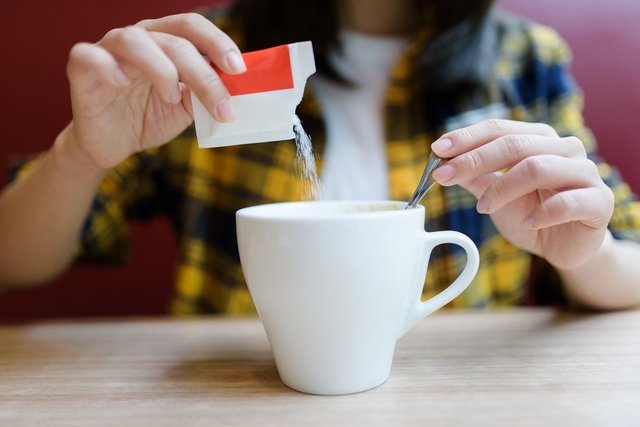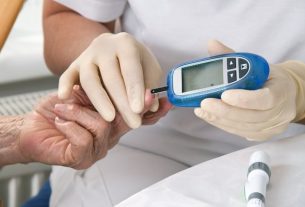Sucralose is an artificial sweetener made from fruit and vegetable sugar, which has a sweetening power of up to 600 times more than regular sugar. Sucralose has no calories and is widely used by the food industry to sweeten products such as soft drinks, cakes and juices.
Furthermore, sucralose is also found in pharmacies, supermarkets and health food stores, and is consumed by people with diabetes to sweeten foods such as coffee and juices, replacing sugar. Sucralose is also used by people who want to lose weight, as it sweetens without leaving an aftertaste in food and without adding calories to the diet.
However, more recent studies have shown that sucralose can cause dysbiosis, which is an imbalance of intestinal flora, thus altering hormone metabolism and increasing the risk of problems such as obesity, diabetes or lactose intolerance. Know the symptoms and learn how to prevent dysbiosis.

Is sucralose bad?
Sucralose is a sweetener considered safe when ingested within recommended amounts, and can even be consumed by pregnant women, breastfeeding women and children.
However, more recent studies have shown that sucralose can cause some changes in the intestinal flora and in the levels of various hormones in the body, favoring situations such as:
- Promote weight gain: the sweetener changes the composition of the intestinal flora, which sends signals to the brain, causing an imbalance in the release of hormones responsible for controlling hunger;
- May promote dysbiosis: sucralose can change the amount and types of beneficial bacteria and “bad” bacteria in the intestine, causing dysbiosis and leading to symptoms such as diarrhea, lactose intolerance, gas, excessive tiredness or mood changes. Find out what it is and see how to treat dysbiosis;
- Can cause diabetes: Although it does not directly increase blood sugar levels, sucralose stimulates sweet taste receptors on the tongue, intestine and stomach, transmitting signals to the brain and stimulating the release of insulin into the blood, which, in excess, can cause resistance. insulin and, consequently, diabetes.
Furthermore, some studies (1) (2) indicate that, when heated, sucralose can release toxic substances, increasing the risk of some types of cancer. However, there is still no scientific proof of this relationship.
Recommended amount of sucralose
The recommended intake amount of sucralose for an adult is 5 mg/kg of body weight per day. For a person weighing 60 kg, the recommended intake of sucralose would be 300 mg per day, for example.
According to the Brazilian Society of Pediatrics, children should only use sweeteners from the age of 2, in cases of diabetes and following the guidance of a pediatrician regarding type and quantity.
Can diabetics consume it?
Sucralose is a sweetener that can be consumed by diabetics, as it helps reduce the intake of white sugar in the diet, favoring the balance of glucose and insulin levels in the blood.
However, sucralose has a sweet taste that also stimulates the release of insulin, which can cause an imbalance in blood sugar levels. Therefore, it is important to use sweeteners in moderation and, whenever possible, try to consume foods without sweetening.
Difference between sucralose and stevia
Sucralose is an artificial sweetener that sweetens up to 600 times that of common sugar and has no residual flavor, being very well tolerated and, therefore, is used in different types of preparations, such as cakes, juices, coffees or teas.
Stevia is a natural sweetener, made from the Stevia Rebaudiana Bertoni plant. This sweetener has the power to sweeten up to 300 times more than common sugar, however it has a slightly bitter taste and, therefore, can alter the flavor of some preparations. Understand all the benefits and see how to use stevia.
Benefits of Sucralose
Sucralose is a sweetener that helps reduce the amount of calories in food, making it a good option to replace sugar in the diet for those who want to maintain weight or for people who want to lose weight.
As it is a sweetener that is not metabolized by microorganisms present in the mouth, sucralose can be a good option to replace white sugar and help prevent tooth cavities. Discover other ways to prevent cavities.
Furthermore, moderate consumption of sucralose can help control blood glucose and insulin levels, and can replace white sugar in the diet of people with diabetes.
Bibliography
- EISENREICH, Andreas et al. Heating of food containing sucralose might result in the generation of potentially toxic chlorinated compounds. Food Chemistry. Vol.391. 1-8, 2020
- OLIVEIRA, N, Diogo; CATHARINO, R, Rodrigo. Thermal degradation of sucralose: a combination of analytical methods to determine stability and chlorinated byproducts. Scientific Reports. Vol.5. 1-5, 2015
- ROMO-ROMO, Alonso et al. Effects of the Non-Nutritive Sweeteners on Glucose Metabolism and Appetite Regulating Hormones: Systematic Review of Observational Prospective Studies and Clinical Trials. PLOS-ONE. 1-17, 2016
- OJEDA, R, Francisco Javier et al. Effects of Sweeteners on the Gut Microbiota: A Review of Experimental Studies and Clinical Trials. Advances in Nutrition. Vol.1. 10.ed; 31-48, 2019
- UNITED STATES FOOD AND DRUG ADMINISTRATION. Additional Information about High-Intensity Sweeteners Permitted for Use in Food in the United States. Disponível em: <https://www.fda.gov/food/food-additives-petitions/additional-information-about-high-intensity-sweeteners-permitted-use-food-united-states>. Acesso em 29 out 2021
- AHMAD, Y, Samar et al. Effect of sucralose and aspartame on glucose metabolism and gut hormones. Nutrition Reviews. Vol.28. 9.ed; 725-746, 2020
- MAYO CLINIC. Artificial sweeteners and other sugar substitutes. Disponível em: <https://www.mayoclinic.org/healthy-lifestyle/nutrition-and-healthy-eating/in-depth/artificial-sweeteners/art-20046936>. Acesso em 29 out 2021
- GUPTA, Prahlad et al. Role of Sugar and Sugar Substitutes in Dental Caries: A Review. ISRN Dentistry. Vol.2013. 1-5, 2013
- MINISTRY OF HEALTH. Demystifying doubts about food and nutrition. 2016. Available at: <https://bvsms.saude.gov.br/bvs/publicacoes/desmistificando_duvidas_sobre_alimenta%C3%A7%C3%A3o_nutricao.pdf>. Accessed on October 29, 2021
- DEPAULDEPAUL UNIVERSITY LIBRARIES. Potential Mechanisms for NNS-Induced Metabolic Deviances: Satiety Hormone Secretion and Alterations in the Gut Microbiota . 2018. Available at: <https://via.library.depaul.edu/cgi/viewcontent.cgi?referer=https://scholar.google.com/&httpsredir=1&article=1122&context=depaul-disc>. Accessed on October 29, 2021

Sign up for our newsletter and stay up to date with exclusive news
that can transform your routine!
Warning: Undefined array key "title" in /home/storelat/public_html/wp-content/plugins/link-whisper-premium/templates/frontend/related-posts.php on line 12
Warning: Undefined array key "title_tag" in /home/storelat/public_html/wp-content/plugins/link-whisper-premium/templates/frontend/related-posts.php on line 13



